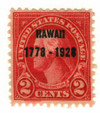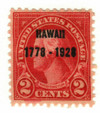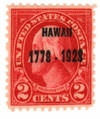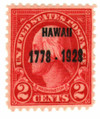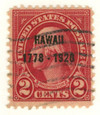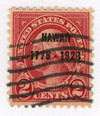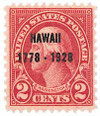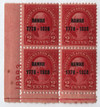
1928 2c Discovery of Hawaii, carmine
# 647 - 1928 2c Discovery of Hawaii, carmine
$3.50 - $1,000.00
U.S. #647
1928 2¢ Discovery of Hawaii
1928 2¢ Discovery of Hawaii
First Day of Issue: August 13, 1928
First City: Honolulu, HI; Washington, D.C.
Quantity Issued: 5,519,897
Printing Method: Rotary Press
Perforation: 11 x 10.5
Color: Carmine
First City: Honolulu, HI; Washington, D.C.
Quantity Issued: 5,519,897
Printing Method: Rotary Press
Perforation: 11 x 10.5
Color: Carmine
In 1928, suggestions were made to issue a stamp commemorating the 150th anniversary of the discovery of Hawaii. Although the Post Office Department initially refused, they eventually agreed to issue a pair of overprinted stamps that would be much less costly than designing and printing new stamps. These Hawaiian Sesquicentennial stamps were overprinted versions of the Regular Series of 1922-26. However, when the stamps were issued, many post offices around the country were unaware of them and refused to accept them, claiming they were already canceled and not fit for postage.
History of the Hawaiian Islands
Polynesians were the first people to settle the Hawaiian Islands. They journeyed across the Pacific, moving from island to island in giant canoes. They probably reached Hawaii around 2,000 years ago. Another group from Tahiti reached the islands in 1200 A.D. and conquered the earlier settlers. The name Hawaii is either derived from the name of a chief, Hawaii-loa, or the legendary name of the Polynesian homeland to the west, Hawaiki.
Although European or Japanese ships may have reached the Hawaiian Islands during the 1500s, Great Britain’s Captain James Cook was responsible for making them known to the rest of the world. Cook landed there on January 18, 1778, and engaged in friendly trade. It is estimated that about 300,000 people lived in Hawaii at that time. The Hawaiians believed Cook had divine powers and considered him a great chief. He named the islands in honor of the first lord of the British admiralty, the Earl of Sandwich. Cook left the Sandwich Islands after two weeks. He returned in November 1778, and was later killed when a fight broke out between the Hawaiians and his men.
Cook’s voyages brought more explorers and traders to Hawaii. The first trading ship stopped there in 1786 while transporting a load of furs from Oregon to China. New types of livestock, manufactured goods, and plants were introduced to the islands. Unfortunately, new diseases took a devastating toll on the islanders.
Local chiefs had controlled the islands throughout Hawaii’s history. In 1782, Chief Kamehameha obtained firearms from European traders and began a bloody war to unite the islands into a kingdom. By 1792, he controlled Hawaii Island. Three years later, he controlled all the main islands except Kauai and Niihau. Kamehameha appointed the local chiefs as governors and proclaimed himself King Kamehameha I. The chiefs of Kauai and Niihau accepted Kamehameha’s rule in 1810.
Hawaii adopted its first constitution in 1840. The United States recognized Hawaii as an independent government in 1842.
King Kalakaua gave the U.S. the right to use Pearl Harbor as a Naval base in 1887 in return for trading privileges. In 1891, Kalakaua died and his sister was crowned Queen Liluokalani. Liluokalani attempted to install a new constitution that would increase her power. In 1893, a group of nine Americans, two Britons, and two Germans led a revolution against Liluokalani, removing her from office. U.S. marines and sailors aided the revolutionaries. In 1894, the Republic of Hawaii was formed. This short-lived nation had just one president, Sanford B. Dole.
Hawaii then came under the control of U.S. businessmen. These businessmen lobbied for Hawaii to be annexed by the U.S. – which was financially beneficial to their interests. On August 12, 1898, the islands were officially annexed and became U.S. possessions. Hawaii became a U.S. territory on June 14, 1900. Hawaiians became U.S. citizens. However, their Congressional representative could not vote and the U.S. Congress could veto any law passed by their legislature.
The first bill attempting to make Hawaii a state was introduced in 1919. In 1950, Hawaii adopted a constitution in preparation for statehood. Congress approved the appropriate legislation in 1959 and President Dwight D. Eisenhower signed the bill. The matter went before the Hawaiian people, who voted 17 to 1 in favor of statehood. On August 21, 1959, Hawaii achieved statehood.
U.S. #647
1928 2¢ Discovery of Hawaii
1928 2¢ Discovery of Hawaii
First Day of Issue: August 13, 1928
First City: Honolulu, HI; Washington, D.C.
Quantity Issued: 5,519,897
Printing Method: Rotary Press
Perforation: 11 x 10.5
Color: Carmine
First City: Honolulu, HI; Washington, D.C.
Quantity Issued: 5,519,897
Printing Method: Rotary Press
Perforation: 11 x 10.5
Color: Carmine
In 1928, suggestions were made to issue a stamp commemorating the 150th anniversary of the discovery of Hawaii. Although the Post Office Department initially refused, they eventually agreed to issue a pair of overprinted stamps that would be much less costly than designing and printing new stamps. These Hawaiian Sesquicentennial stamps were overprinted versions of the Regular Series of 1922-26. However, when the stamps were issued, many post offices around the country were unaware of them and refused to accept them, claiming they were already canceled and not fit for postage.
History of the Hawaiian Islands
Polynesians were the first people to settle the Hawaiian Islands. They journeyed across the Pacific, moving from island to island in giant canoes. They probably reached Hawaii around 2,000 years ago. Another group from Tahiti reached the islands in 1200 A.D. and conquered the earlier settlers. The name Hawaii is either derived from the name of a chief, Hawaii-loa, or the legendary name of the Polynesian homeland to the west, Hawaiki.
Although European or Japanese ships may have reached the Hawaiian Islands during the 1500s, Great Britain’s Captain James Cook was responsible for making them known to the rest of the world. Cook landed there on January 18, 1778, and engaged in friendly trade. It is estimated that about 300,000 people lived in Hawaii at that time. The Hawaiians believed Cook had divine powers and considered him a great chief. He named the islands in honor of the first lord of the British admiralty, the Earl of Sandwich. Cook left the Sandwich Islands after two weeks. He returned in November 1778, and was later killed when a fight broke out between the Hawaiians and his men.
Cook’s voyages brought more explorers and traders to Hawaii. The first trading ship stopped there in 1786 while transporting a load of furs from Oregon to China. New types of livestock, manufactured goods, and plants were introduced to the islands. Unfortunately, new diseases took a devastating toll on the islanders.
Local chiefs had controlled the islands throughout Hawaii’s history. In 1782, Chief Kamehameha obtained firearms from European traders and began a bloody war to unite the islands into a kingdom. By 1792, he controlled Hawaii Island. Three years later, he controlled all the main islands except Kauai and Niihau. Kamehameha appointed the local chiefs as governors and proclaimed himself King Kamehameha I. The chiefs of Kauai and Niihau accepted Kamehameha’s rule in 1810.
Hawaii adopted its first constitution in 1840. The United States recognized Hawaii as an independent government in 1842.
King Kalakaua gave the U.S. the right to use Pearl Harbor as a Naval base in 1887 in return for trading privileges. In 1891, Kalakaua died and his sister was crowned Queen Liluokalani. Liluokalani attempted to install a new constitution that would increase her power. In 1893, a group of nine Americans, two Britons, and two Germans led a revolution against Liluokalani, removing her from office. U.S. marines and sailors aided the revolutionaries. In 1894, the Republic of Hawaii was formed. This short-lived nation had just one president, Sanford B. Dole.
Hawaii then came under the control of U.S. businessmen. These businessmen lobbied for Hawaii to be annexed by the U.S. – which was financially beneficial to their interests. On August 12, 1898, the islands were officially annexed and became U.S. possessions. Hawaii became a U.S. territory on June 14, 1900. Hawaiians became U.S. citizens. However, their Congressional representative could not vote and the U.S. Congress could veto any law passed by their legislature.
The first bill attempting to make Hawaii a state was introduced in 1919. In 1950, Hawaii adopted a constitution in preparation for statehood. Congress approved the appropriate legislation in 1959 and President Dwight D. Eisenhower signed the bill. The matter went before the Hawaiian people, who voted 17 to 1 in favor of statehood. On August 21, 1959, Hawaii achieved statehood.





